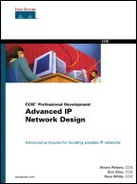Loop Free Routes in EIGRP Networks
To understand how EIGRP determines if a path is valid (loop free), take a look at Figure C-3, which is a simple geometric figure. Each line here is assigned a length of 1 for simplicity. (Figure C-4 applies the same mechanics using real metrics.)
Figure C-3. Model for Valid Route Discovery

Because the length of each of these line segments is 1, the following total distances would be true:
B to C=1
A to B to C=2
D to B to C=2
A to D to B to C=3
D to A to B to C=3
B to A to D to B to C=4
B to D to A to B to C=4
If A advertises to B that it has a path to C through D, the total distance it advertises is 3. This is greater than B's best path to C, which is 1. In fact, it's mathematically impossible for A to ever advertise a better route to C than B's best path because it always includes the distance between B and C.
Given this, it's relatively simple for B to determine if the path to C that A is advertising has already passed through B (and if it is looped, or invalid)—simply compare the total distance A is advertising with the best path currently known. If the path A is advertising is longer (has a higher total distance) than the best path currently known, it's possible that the advertised path is a loop and shouldn't be used.
With this in mind, look at the example in Figure C-4 and see how this works with real metrics.
Figure C-4. EIGRP Loop Detection

Router B will receive three advertisements for 10.1.1.0/24 as follows:
Through Router A with a metric of 2500096
Through Router C with a metric of 281600
Through Router D with a metric of 2500096
Normally, Router B receives only one of these advertisements—through Router C—because of split-horizon. Split-horizon is turned off in this example to explain how EIGRP finds invalid routes based only on the metrics.
Router B adds the metric through the interface that it receives the advertisements on, and now it has these paths:
Through Router A with a metric of 2756096
Through Router C with a metric of 1988096
Through Router D with a metric of 2756096
Now, Router B chooses the best path (lowest metric) to 10.1.1.0/24, which is through Router C, and uses this as a "measuring stick." Because the distances advertised by Routers A and D (before Router B adds the metrics in through its interfaces) are both higher than the best path (after Router B adds in its interface metrics), neither of these paths are valid.
Remember from the previous example in Figure C-3 that it's mathematically impossible for the metric through A or D to be lower than the total distance to the destination if the path contains a loop (passes through B more than once).
To put this in EIGRP terms:
The distance to the destination advertised by the neighbor is the reported distance.
The best metric available to the network is the feasible distance.
The neighbor with the best metric to a destination is the successor.
Any neighbors whose reported distances are less than the feasible distance are feasible successors. (They are advertising a loop free route.)
This model is conservative. Sometimes, a route is determined to be a possible loop when it isn't.
